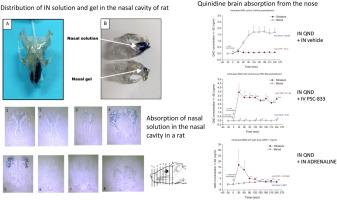当前位置:
X-MOL 学术
›
Brain Res. Bull.
›
论文详情
Our official English website, www.x-mol.net, welcomes your
feedback! (Note: you will need to create a separate account there.)
Modulation of nose-to-brain delivery of a P-glycoprotein (MDR1) substrate model drug (quinidine) in rats.
Brain Research Bulletin ( IF 3.5 ) Pub Date : 2020-04-26 , DOI: 10.1016/j.brainresbull.2020.04.012 Luca Anna Bors 1 , Ágnes Bajza 1 , Míra Mándoki 2 , Benedek József Tasi 1 , György Cserey 1 , Tímea Imre 3 , Pál Szabó 3 , Franciska Erdő 1
Brain Research Bulletin ( IF 3.5 ) Pub Date : 2020-04-26 , DOI: 10.1016/j.brainresbull.2020.04.012 Luca Anna Bors 1 , Ágnes Bajza 1 , Míra Mándoki 2 , Benedek József Tasi 1 , György Cserey 1 , Tímea Imre 3 , Pál Szabó 3 , Franciska Erdő 1
Affiliation

|
During the last decades several new drug formulations were developed to target the central nervous system (CNS) from the nasal cavity. However, in these studies less attention was paid to the possible drug-drug interactions in case of multi-drug therapy. In our pilot study first we compared a nasal solution and a nasal gel to demonstrate their distribution in the nasal cavity (3D printed rat skull model and histology). Due to the aspiration induced high mortality at administration of nasal solution the study was continued only with the gel formulation of quinidine. The aim of our experiments was to identify the possible functional role of P-glycoprotein (P-gp) in the drug absorption in nasal cavity and to test drug-drug interactions at nose-to-brain delivery. Therefore, a P-gp substrate model drug, quinidine was tested by intranasal (IN) administration in presence of PSC-833 (specific P-gp inhibitor) given intravenously (IV) or IN and adrenaline (IN) at low (50 ng) or high (20 μg) dose. In control animals the brain penetration of quinidine was at the level of detection limit, but in combination therapy with IV PSC-833 the brain levels increased dramatically, similarly to high dose IN adrenalin, where due to vasoconstriction peripheral distribution was blocked. These results indicate that P-gp has an important role in drug absorption and efflux at nasal cavity, while adrenaline is also able to modify the penetration profile of the P-gp substrate model drug at nasal application as it decreases nose-to-blood absorption, letting more quinidine to reach the brain along with the nasal nerves.
中文翻译:

在大鼠中调节 P-糖蛋白 (MDR1) 底物模型药物(奎尼丁)的鼻-脑递送。
在过去的几十年中,开发了几种新的药物制剂,以从鼻腔靶向中枢神经系统 (CNS)。然而,在这些研究中,对多药治疗中可能的药物相互作用的关注较少。在我们的试点研究中,我们首先比较了鼻腔溶液和鼻腔凝胶,以证明它们在鼻腔中的分布(3D 打印大鼠颅骨模型和组织学)。由于吸入鼻腔溶液引起的高死亡率,仅用奎尼丁凝胶制剂继续研究。我们实验的目的是确定 P-糖蛋白 (P-gp) 在鼻腔药物吸收中可能的功能作用,并测试鼻对脑给药时的药物相互作用。因此,一种 P-gp 底物模型药物,在静脉内 (IV) 或 IN 和肾上腺素 (IN) 以低 (50 ng) 或高 (20 μg) 剂量给予 PSC-833(特异性 P-gp 抑制剂)的情况下,通过鼻内 (IN) 给药来测试奎尼丁。在对照动物中,奎尼丁的脑渗透处于检测极限水平,但在与 IV PSC-833 联合治疗中,脑水平显着增加,类似于高剂量 IN 肾上腺素,由于血管收缩,外周分布被阻断。这些结果表明 P-gp 在药物吸收和鼻腔外排方面具有重要作用,而肾上腺素也能够改变鼻腔应用时 P-gp 底物模型药物的渗透曲线,因为它降低了鼻对血的吸收,让更多的奎尼丁随着鼻神经到达大脑。
更新日期:2020-04-26
中文翻译:

在大鼠中调节 P-糖蛋白 (MDR1) 底物模型药物(奎尼丁)的鼻-脑递送。
在过去的几十年中,开发了几种新的药物制剂,以从鼻腔靶向中枢神经系统 (CNS)。然而,在这些研究中,对多药治疗中可能的药物相互作用的关注较少。在我们的试点研究中,我们首先比较了鼻腔溶液和鼻腔凝胶,以证明它们在鼻腔中的分布(3D 打印大鼠颅骨模型和组织学)。由于吸入鼻腔溶液引起的高死亡率,仅用奎尼丁凝胶制剂继续研究。我们实验的目的是确定 P-糖蛋白 (P-gp) 在鼻腔药物吸收中可能的功能作用,并测试鼻对脑给药时的药物相互作用。因此,一种 P-gp 底物模型药物,在静脉内 (IV) 或 IN 和肾上腺素 (IN) 以低 (50 ng) 或高 (20 μg) 剂量给予 PSC-833(特异性 P-gp 抑制剂)的情况下,通过鼻内 (IN) 给药来测试奎尼丁。在对照动物中,奎尼丁的脑渗透处于检测极限水平,但在与 IV PSC-833 联合治疗中,脑水平显着增加,类似于高剂量 IN 肾上腺素,由于血管收缩,外周分布被阻断。这些结果表明 P-gp 在药物吸收和鼻腔外排方面具有重要作用,而肾上腺素也能够改变鼻腔应用时 P-gp 底物模型药物的渗透曲线,因为它降低了鼻对血的吸收,让更多的奎尼丁随着鼻神经到达大脑。









































 京公网安备 11010802027423号
京公网安备 11010802027423号